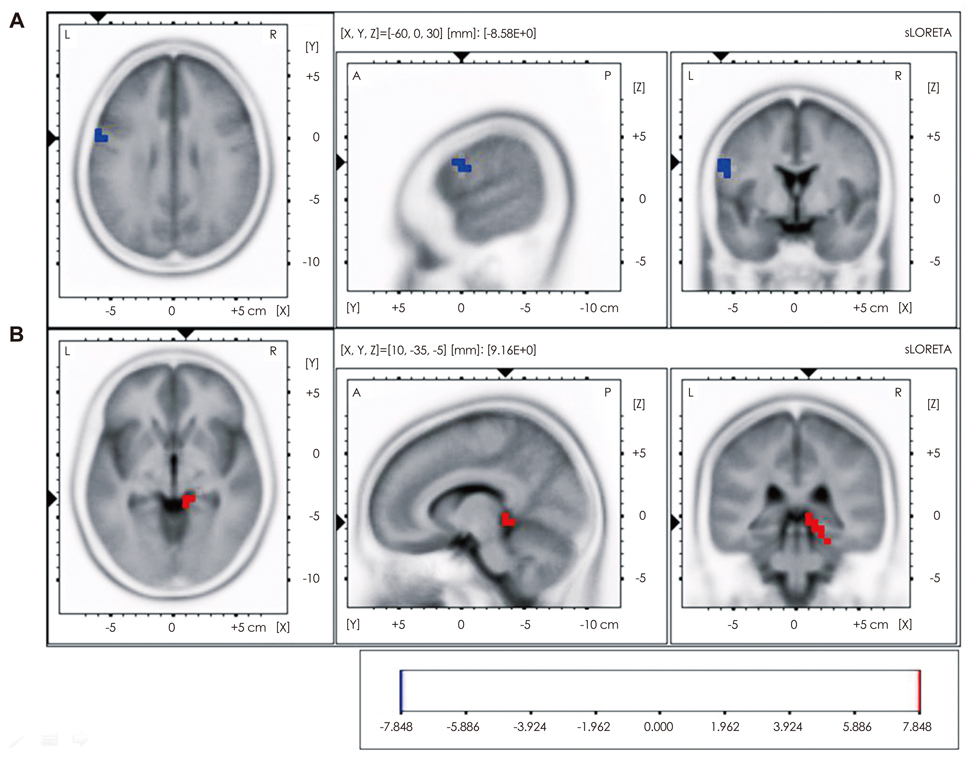J Clin Neurol.
2012 Sep;8(3):238-240. 10.3988/jcn.2012.8.3.238.
Medial Temporal Activation in Mal de Debarquement Syndrome Revealed by Standardized Low-Resolution Brain Electromagnetic Tomography
- Affiliations
-
- 1Department of Neurology, Chungnam National University College of Medicine, Chungnam National University Hospital, Daejeon, Korea.
- 2Department of Neurology, Korea University Medical Center, Korea University College of Medicine, Seoul, Korea. jungky@korea.ac.kr
- 3Department of Neurology, Seoul National University College of Medicine, Seoul National University Bundang Hospital, Seongnam, Korea.
- KMID: 2287598
- DOI: http://doi.org/10.3988/jcn.2012.8.3.238
Abstract
- BACKGROUND
Mal de debarquement (MdD) literally means "sickness of disembarkation", and refers to the illusion of movement perceived as an after-effect of traveling on a boat, train, or airplane. The pathophysiology of MdD is currently unknown.
CASE REPORT
A 20-year-old man presented with dizziness and swaying sensation for 3 days after a boat trip. Compared with the follow-up EEG without symptoms, the EEG recorded while having MdD symptoms disclosed a significantly decreased alpha-band current source density at the precentral gyrus of the left frontal lobe and increased beta-2 activity at the parahippocampal gyrus of right mesial temporal region.
CONCLUSIONS
Our results provide evidence of deranged cortical activity in MdD. To the best of our knowledge this is the first study to document cortical correlates of MdD using an EEG source-localization method.
Keyword
MeSH Terms
Figure
Reference
-
1. Cha YH. Mal de debarquement. Semin Neurol. 2009. 29:520–527.
Article2. Pascual-Marqui RD. Standardized low-resolution brain electromagnetic tomography (sLORETA): technical details. Methods Find Exp Clin Pharmacol. 2002. 24:Suppl D. 5–12.3. Gu Y, DeAngelis GC, Angelaki DE. A functional link between area MSTd and heading perception based on vestibular signals. Nat Neurosci. 2007. 10:1038–1047.
Article4. Brandt T, Schautzer F, Hamilton DA, Brüning R, Markowitsch HJ, Kalla R, et al. Vestibular loss causes hippocampal atrophy and impaired spatial memory in humans. Brain. 2005. 128:2732–2741.
Article5. Perlis ML, Merica H, Smith MT, Giles DE. Beta EEG activity and insomnia. Sleep Med Rev. 2001. 5:363–374.
Article6. Kluge M, Beyenburg S, Fernández G, Elger CE. Epileptic vertigo: evidence for vestibular representation in human frontal cortex. Neurology. 2000. 55:1906–1908.
Article7. Krings T, Chiappa KH, Cuffin BN, Cochius JI, Connolly S, Cosgrove GR. Accuracy of EEG dipole source localization using implanted sources in the human brain. Clin Neurophysiol. 1999. 110:106–114.
Article
- Full Text Links
- Actions
-
Cited
- CITED
-
- Close
- Share
- Similar articles
-
- Mal de Debarquement Syndrome with Apogeotropic Positional Nystagmus
- Location of Brain Electrical Source Activation according to Visually Stimulated Sexual Arousal: A Cross Spectral Analysis using Low Resolution Brain Electromagnetic Tomography (LORETA)
- Location of Brain Electrical Source Activation by Visually Stimulated Sexual Arousal in Young Men and Women: a Cross Spectral Analysis using Low Resolution Brain Electromagnetic Tomography (LORETA)
- Comparison of Low Resolution Electromagnetic Tomography Imaging Between Subjects With Mild and Severe Obstructive Sleep Apnea Syndrome: A Preliminary Study
- Electroencephalographic Characteristics of Alcohol Dependent Patients: 3-Dimensional Source Localization


